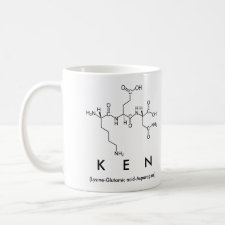
Authors: Sellergren B, Karmalkar RN, Shea KJ
Article Title: Enantioselective ester hydrolysis catalyzed by imprinted polymers. 2.
Publication date: 2000
Journal: Journal of Organic Chemistry
Volume: 65
Issue: (13)
Page numbers: 4009-4027.
DOI: 10.1021/jo000014n
Abstract: Highly cross-linked network polymers prepared by molecular imprinting catalyzed enantioselectively the hydrolysis of N- tert-butoxycarbonyl phenylalanine-p-nitrophenyl ester (BOCPheONP). The templates were designed to allow incorporation of the key catalytic elements, found in the proteolytic enzyme chymotrypsin, into the polymer active sites. Three model systems were evaluated. These were constructed from a chiral phosphonate analogue of phenylalanine (series A, C) or L- phenylalanine (series B) attached by a labile ester Linkage to an imidazole-containing vinyl monomer. Free radical copolymerization of the template with methacrylic acid (MAA) and ethylene glycol dimethacrylate (EDMA) gave a highly cross- linked network polymer. The templates could be liberated from the polymers by hydrolysis, giving catalytically active sites envisaged to contain an enantioselective binding site, a site complementary to a transition state like structure (series A, C), and a hydroxyl, imidazole, and carboxylic acid group at hydrogen bond distance. As predicted, the enantiomer of BOCPheONP complementary to the configuration of the template was preferentially hydrolyzed with D-selectivity for the series A polymers (kD/kL = 1.9) and L-selectivity for the series B polymers (kL/kD = 1.2). The maximum rate enhancement, when compared with a control polymer, prepared using a benzoyl- substituted imidazole monomer as template, was 2.5, and comparing with the imidazole monomer in solution, a maximum rate enhancement of 10 was observed. The catalytic activity was higher for polymers subjected to the nucleophilic treatment. This was explained by a higher site density and flexibility of the polymer matrix caused by this treatment. In a comparison of template rebinding to polymers imprinted with a template containing either a carboxylate (planar ground state structure) or a-phosphonate (tetrahedral transition state like structure) functionality, it was observed that imprinted polymers are able to discriminate between a transition state like and a ground state structure for transesterification. However the influence of transition state stabilization on the observed rate enhancements remains obscure. Only at acidic pH's was catalysis observed, whereas at basic pH's the polymers inhibit the reaction. At a later stage, the catalytic activity of the polymers for nonactivated D- and L-phenylalanine ethyl esters was investigated. A rate enhancement of up to 3 was observed when compared to the blank. Mast important, however, the polymers imprinted with a D template preferentially hydrolyzed the D-ethyl ester and exhibited saturation kinetics



Join the Society for Molecular Imprinting

New items RSS feed
Sign-up for e-mail updates:
Choose between receiving an occasional newsletter or more frequent e-mail alerts.
Click here to go to the sign-up page.
Is your name elemental or peptidic? Enter your name and find out by clicking either of the buttons below!
Other products you may like:
 MIPdatabase
MIPdatabase









